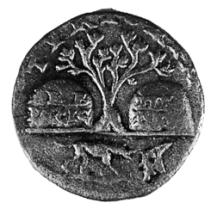Tyrian purple
(Redirected from Punicin)
Tyrian purple, also known as Phoenician purple, royal purple, or imperial purple, is a dye that was highly valued in ancient civilizations such as the Phoenicians, Egyptians, and Romans. This dye is known for its striking purple color and was made from the mucus of certain species of sea snails, primarily the Murex brandaris (now known as Hexaplex trunculus), found in the Mediterranean Sea. The production of Tyrian purple was a labor-intensive and costly process, which made the dye extremely valuable and a symbol of wealth, power, and prestige.
History[edit | edit source]
The discovery of Tyrian purple dates back to around 1500 BCE, with the Phoenicians, a seafaring people of the eastern Mediterranean, being credited with its first use. The city of Tyre, in modern-day Lebanon, became the center of Tyrian purple production, giving the dye its name. The dye was produced by extracting a small amount of mucus from the hypobranchial gland of the Murex snail, then exposing it to sunlight. The chemical reaction from the sunlight exposure turned the mucus into a durable and vibrant purple dye.
Throughout history, Tyrian purple was associated with royalty and divinity. In the Roman Empire, laws restricted the wearing of Tyrian purple to the emperor and his imperial family, with penalties for those who wore it without authorization. This association with the imperial class led to the term "born to the purple," referring to someone born into nobility.
Production[edit | edit source]
The production of Tyrian purple was extremely laborious. Thousands of Murex snails were required to produce just a few grams of the dye, making it more precious than gold. The snails were collected, and their glands were extracted and crushed. The crushed material was then exposed to sunlight, undergoing a chemical transformation that resulted in the purple dye. This process was not only time-consuming but also had a significant environmental impact, leading to the overharvesting of Murex snails.
Cultural Significance[edit | edit source]
Tyrian purple held immense cultural significance in ancient societies. It was a symbol of power, used in the robes of kings, emperors, and high-ranking priests. The dye's rarity and cost meant that it was often reserved for the upper echelons of society, reinforcing social hierarchies. In addition to its use in clothing, Tyrian purple was also used in the production of scrolls and manuscripts, further emphasizing its importance in ancient cultures.
Decline and Legacy[edit | edit source]
The use of Tyrian purple declined with the fall of the Roman Empire. The complex production process and the advent of cheaper alternatives led to its gradual disappearance. However, the legacy of Tyrian purple continues to influence modern perceptions of purple as a color associated with luxury, power, and royalty.
| This article is a stub. You can help WikiMD by registering to expand it. |
Search WikiMD
Ad.Tired of being Overweight? Try W8MD's physician weight loss program.
Semaglutide (Ozempic / Wegovy and Tirzepatide (Mounjaro / Zepbound) available.
Advertise on WikiMD
|
WikiMD's Wellness Encyclopedia |
| Let Food Be Thy Medicine Medicine Thy Food - Hippocrates |
Translate this page: - East Asian
中文,
日本,
한국어,
South Asian
हिन्दी,
தமிழ்,
తెలుగు,
Urdu,
ಕನ್ನಡ,
Southeast Asian
Indonesian,
Vietnamese,
Thai,
မြန်မာဘာသာ,
বাংলা
European
español,
Deutsch,
français,
Greek,
português do Brasil,
polski,
română,
русский,
Nederlands,
norsk,
svenska,
suomi,
Italian
Middle Eastern & African
عربى,
Turkish,
Persian,
Hebrew,
Afrikaans,
isiZulu,
Kiswahili,
Other
Bulgarian,
Hungarian,
Czech,
Swedish,
മലയാളം,
मराठी,
ਪੰਜਾਬੀ,
ગુજરાતી,
Portuguese,
Ukrainian
Medical Disclaimer: WikiMD is not a substitute for professional medical advice. The information on WikiMD is provided as an information resource only, may be incorrect, outdated or misleading, and is not to be used or relied on for any diagnostic or treatment purposes. Please consult your health care provider before making any healthcare decisions or for guidance about a specific medical condition. WikiMD expressly disclaims responsibility, and shall have no liability, for any damages, loss, injury, or liability whatsoever suffered as a result of your reliance on the information contained in this site. By visiting this site you agree to the foregoing terms and conditions, which may from time to time be changed or supplemented by WikiMD. If you do not agree to the foregoing terms and conditions, you should not enter or use this site. See full disclaimer.
Credits:Most images are courtesy of Wikimedia commons, and templates, categories Wikipedia, licensed under CC BY SA or similar.
Contributors: Prab R. Tumpati, MD






